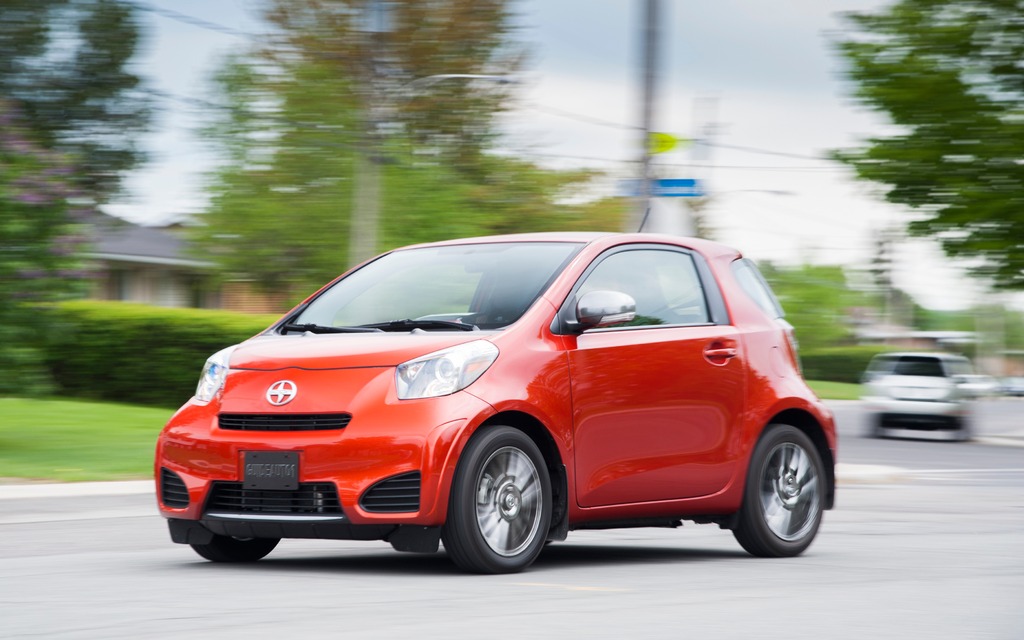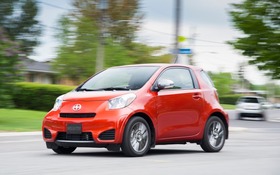2014 Scion iQ / Aston Martin Cygnet: Cute Microcars

| Strong points |
|
|---|---|
| Weak points |
|
The Scion iQ still turns heads when it turns a corner. Even though Scion’s diminutive offering has been driving on Canadian roads since 2012, onlookers will still gawk at it, not with the gaze of amazement that comes when spotting some European exotic car, but more with a look of curiosity, and that look is usually followed by a smile of approval. Most people find Scion’s microcar cute.
And cute it is, with its wedge-shaped nose, abbreviated rear end and 16-inch wheels with low-profile tires, it looks like the real-life automobile version of a Japanese anime character.
With a wheelbase of exactly two metres, it’s the smallest four-seater on the market. Compared to the Smart fortwo, the iQ’s two extra seats are a positive selling point, however, in reality it is a four-seater in spirit only. Scion cleverly (or maybe regretfully) omitted installing a glovebox, therefore the front passenger seat is offset slightly forward to allow more room for a rear passenger. Despite this, tight accommodations back there will limit rear seat time to short rides around town. And that fourth passenger? Well, suffice it to say that it should either be a Cirque de Soleil contortionist or a bag of groceries; with the front seat adjusted fore even a person of small stature there’s just no reasonable rear legroom available.
Despite an almost intimate relationship between the rear passengers and the rear hatch, they are nonetheless protected by the industry’s first rear airbag. The iQ has 11 airbags in total.
Small but… small
As a smart iQ owner (pun intended) you’d make better use of the rear accommodations for carrying luggage or groceries, as storage capacity is just 99 litres with both of the 50/50-split rear seatbacks in the upright position up. With both rear seatbacks folded down, storage capacity increases to 473 litres, bettering the Smart Fortwo’s available cargo space by 133 litres.
The iQ is very light, and with a curb weight of 965 kg it is the only other car available in Canada aside from the Smart that weighs less than 1,000 kg. That light weight, combined with its 1.3-litre, four-cylinder engine, contributes to a combined fuel consumption of 5.1L/100 km, which is about the equivalent of a mid sized motorcycle. It’s actually 0.2L/100 km better than the Smart fortwo.
The iQ’s engine is among the smallest on the market; only the Smart Car’s 1.0-litre three-cylinder is smaller. It produces 94 horsepower, a respectable output considering the car’s small size, but its performance potential is diluted by the iQ’s automatic CVT, the only available transmission.
Controls are basic, and there is a refreshingly minimal amount of buttons on the dashboard. The radio is mounted high on the centre stack, and looks like an aftermarket addition, but it is located there to increase legroom for the front passengers. Another indication of this is the vertically stacked climate control buttons.
Scion made purchasing an iQ quite easy; only one trim level is available and you can choose from a handful of internal and external accessories. It’s rather unfortunate that the purchase price doesn’t include satellite radio or Bluetooth capability, and if you want both those feature you have to select the optional premium sound system for $610.
Scion is celebrating its 10th anniversary in North America this year, and the company is marking the occasion by releasing limited edition 10 Series models. Even though Toyota’s youth-focused brand entered the Canadian market in 2010, we will still get the Scion 10 iQ. This special edition will include several exclusive features like special silver paint, an illuminated shifter knob, aluminum wheels, silver-coloured seat belts, a switchblade key, and the most interesting feature of all, illuminated external Scion badges.
You must make several compromises when considering an iQ as a main automobile. Its small size makes it prone to react to sidewinds on the highway, and its limited interior space doesn’t make it the smartest choice if you want to hit the beach with a few friends. Its starting price of $17,070 (2013) is about $2,600 more than the Smart fortwo, but the iQ is also roomier, has more power and equivalent fuel efficiency.
However, Toyota’s own three-door Yaris starts at $14,255, has actual room for four adults, more storage space and its fuel consumption isn’t that far off the iQ, at 6.0L/100 km combined with the manual gearbox. It makes a difficult argument for those endorsing the iQ.
iQ’s well-dressed cousin
There has been talk for several years that another high-end automobile, based on the iQ, will be coming to Canada, but this has yet to happen. The Aston Martin Cygnet is a rebadged iQ with a lavish interior. You’ll find hand-stitched leather, machined aluminum trim, an Alcantara headliner, keyless entry and pushbutton start among other high-end interior luxuries. Outside you can marvel at the Aston Martin badges and grille. It also comes with a six-speed manual, with an optional CVT.
If you’re wondering why a company with a prestigious pedigree would produce a microcar with lavish trimmings, it is to help reduce the company’s carbon footprint and help it meet fleet CO2 emissions.
Currently Aston Martin will only sell the Cygnet to owners of Aston Martin automobiles. This way they can avoid the embarrassment of having people claim they own an Aston Martin and then pull up in a… glorified iQ.











